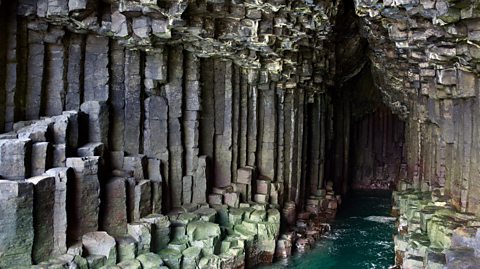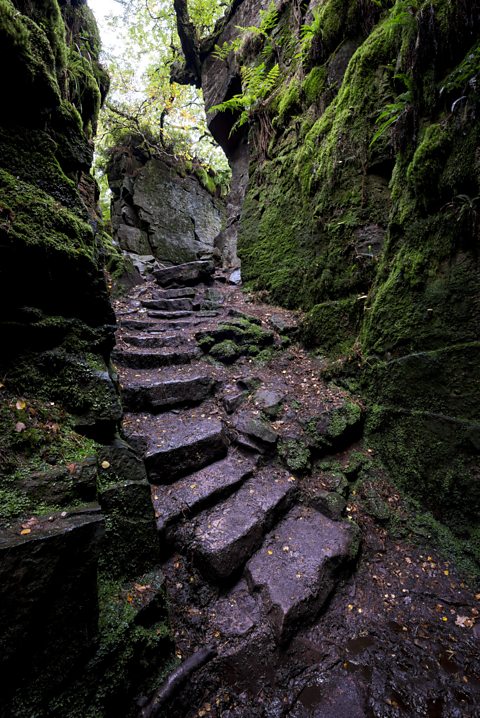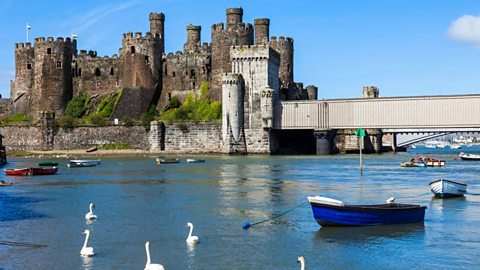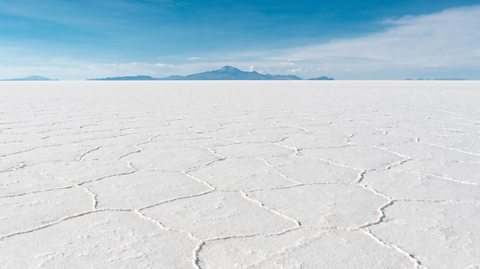The British Isles are full of incredible natural spectacles.
Over time, myths sprung up to help explain or connect the inhabitants of this part of the world to the landmarks around them.
91»»±¨ Bitesize has looked into some of these stories.

Fingal’s Cave, Isle of Staffa, Scotland
On the small, uninhabited island of Staffa, just off the west coast of Scotland, you’ll find this magnificent rock structure known as Fingal’s Cave.
The hexagonal columns that create the intricately textured patterns were formed millions of years ago through volcanic eruptions.
The name Staffa comes from an old Norse word meaning 'stave’ or ‘pillar’, showing just how significant these structures have been for many years.
Fingal’s Cave gets its name from the famous giant of Scottish and Irish mythology, Fionn Mac Cumhail, or Finn McCool in English (don’t you wish you had that name?). Legend has it that Fionn created the Giant’s Causeway, a similar rock structure in Northern Ireland, in order to build a bridge to do battle with another giant in Scotland.

Lud’s Church, Peak District, England
On either side of you in this rocky corridor, the strikingly green, mossy walls stretch up to 18 metre high - a real wonder of nature.
This spot is assumed to be the Green Chapel, home of the Green Knight in the legend of Sir Gawain and the Green Knight.
The story goes that the Green Knight allowed any knight to strike him with his own axe, provided that he could return a strike in a year and a day. Sir Gawain accepts the challenge and lops the Green Knight’s head off.
But the Green Knight isn’t defeated - he simply carries his head with him as he rides away.
A year and a day later, it’s Sir Gawain’s turn to find the Green Knight and receive the strike, so he travels off to the Green Chapel to accept his fate.
But this is not the only myth with Lud's Church as its setting: legend has it that Robin Hood and Friar Tuck hid from the authorities in the chasm.
According to another story from much later on, Bonnie Prince Charlie and his bodyguards slept in Lud's Church while on their way to Manchester, as part of what became known as the as the Forty-Five - an attempt by the prince to regain the British throne for the Stuarts.


Lough Neagh, Northern Ireland
As the largest lake in the UK by surface area, this place has captured the imagination of many storytellers. At around 18 miles long and 15 miles wide, you could be forgiven for thinking you're looking at a stretch of sea. Visiting it, you’ll find an array of wildlife, especially birds naturally drawn to the boglands.
The story of the creation of Lough Neagh is once again related to the legendary giant Fionn Mac Cumhail. Fighting with a Scottish giant (as he often did!), he drew a clump of earth from the ground and attempted to throw it at his enemy. Misjudging his strength, he threw it too far, forming the Isle of Man where it supposedly landed.
The crater it left in Northern Ireland filled up with water to form Lough Neagh.

Pistyll Rhaeadr Waterfall, Berwyn Mountains, Wales
Surrounded by rivers, trees, and mountains, this 240 feet high waterfall in the Berwyn Mountains is a true force of nature, having worn through the rock and formed an archway.
Wales is home to many tales of dragons, and it’s said that one once lived at the top of this waterfall, in the lake of Llyn Lluncaws.
Known as Gwybr of Llanrhaeadr, the creature would swoop down and take women, children and animals from nearby villages todevour them.
Upon the advice of a wise woman, the villagers set up a trap to slay the beast.
Seeing a fire in the distance, the dragon believed another dragon was nearby, so attacked it.
But this fire was in fact a stone pillar, covered in metal spikes and flaming linen. The dragon’s attack caused it to impale itself with the spikes, eventually dying.
Pistyll Rhaeadr Waterfall is one of the Seven Wonders of Wales, which were listed in rhyme in an anonymous poem from the 18th Century:
"Pistyll Rhaeadr and Wrexham steeple,
Snowdon's mountain without its people,
Overton yew trees, St Winefride's well,
Llangollen bridge and Gresford bells."
This article was published in June 2024

Five UK castles steeped in folklore
The stories behind the legends that fascinate visitors

Five natural geological wonders from across the world
The foundation of the Earth has created some beautiful landscapes - here are some of them.

Five places you didn’t know were on UNESCO’s World Heritage Site list
Aqueducts, remote islands and Industrial Revolution sites in the UK all feature on the list.
